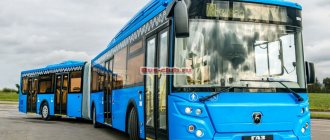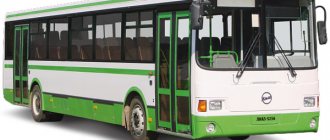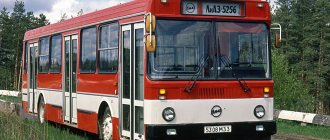Bus LiAZ-6213. Photo Wikipedia
LiAZ-6213 is an articulated low-floor city bus with an especially large capacity produced by the Likinsky Bus Plant, the first passenger transport of this type in Russia. Designed for large cities with intense and super-intensive passenger flows. Serial production began in 2008; from November 2014 to October 2016, production was frozen. The review provides information about both the base model and all modifications, as well as modifications currently offered by the manufacturer and suppliers (January 2020).
Detailed description, device
The first domestic low-floor articulated bus. Thanks to the low floor level, spacious and modern interior, convenient storage areas, and large passenger capacity (153 people), the bus is indispensable on routes with intense passenger traffic, typical of large cities.
The model was - new front and rear masks were used, new head optics were installed, and modern design of the interior and driver's workplace was installed.
When installing a gas engine, 9 gas cylinders are located on the roof of the bus.
LiAZ-6213 was recognized as the “Best bus in terms of cost of ownership” according to independent experts of ASM-Holding OJSC and the Za Rulem magazine.
The interior of the articulated bus LiAZ-6213. Photo YarCamp
Outwardly it looks impressive , similar to a standard low-floor large-class bus with two axles, to which another rear part of the same bus on an individual axle is connected by means of an accordion. The body of the model itself is a supporting structure. The trailer part is not much different in terms of design. There are a large number of simple rectangular lines.
The bus received a large glass area , and in the upper part there was an information board with LED filling. A large number of body elements are made of plastic. The manufacturer provides a 12-year warranty against through corrosion.
The salon has a comfortable seating arrangement, high-quality finishing materials and thoughtful ergonomics.
The driver's seat has pronounced support, air suspension and a long lower part. The 4-spoke LiAZ-6213 steering wheel looks thin and modest, but the steering column has several positions. There is no instrument panel as such, and the entire center panel and plastic to the left of the driver is strewn with a large number of buttons and sensors. There is also a removable on-board computer display in color.
You can enter the salon through four double doors, which have a completely glass structure. There are a total of 153 passenger seats in the cabin. Of these, 34 are seated. There is also a designated area for people with disabilities. By default, for greater comfort, the bus is equipped with heating and ventilation systems, and optionally you can order two air conditioners and an audio system.
History of creation
Today the LiAZ 6213 bus is successfully operated in many Russian cities. However, not everyone knows that in the period from 2014 to 2016. production was frozen.
During the entire production period, many modifications were released. Each new generation was distinguished by even greater comfort and capacity, as well as corrections of shortcomings of previous releases. One of the modern models LiAZ 6213 71 has become the best in combination of price and performance characteristics, according to experts.
Features of the base model
City bus LiAZ-6213. Photo Wikipedia
All-metal carriage-type body, 4 hinged doors with pneumatic drive.
The layout of the LiAZ-6213 interior implies the presence of 37 + 1 seats, the total number of sitting and standing places is 184. There is a place for a wheelchair user . There is a ramp in the middle of the salon , and there are no steps at the entrance. Therefore, traveling on such a bus is convenient not only for ordinary passengers, but also for people with disabilities.
Panoramic windshield , separate headlights and turn signals.
Tinted side windows and a top-mounted LED display.
The body is of a monocoque type.
Braking system with two pneumatic circuits, ABS.
Body parts, including the bumper, made of polymer materials . The warranty on plastic elements that are resistant to the destructive effects of corrosion is 12 years.
Articulated bus and trailer, the presence of a rotating accordion.
The driver's seat is separated from the passenger compartment by a transparent partition , equipped with a pneumatic drive, and has a wide range of adjustments.
The presence of an on-board computer and four cameras providing a convenient overview of the situation in the cabin.
The steering wheel is four-spoke, with hydraulic booster, the ignition switch is in the steering column.
Climate control unit.
The rear axle is driven, with disc brakes and a central bevel gearbox.
Modifications: LiAZ-6213-21, 6213-22, 6213.65-79 and others
Diesel engine versions
Bus LiAZ-6213.20. Photo Wikipedia
6213.00. The first copy of the LiAZ-6213 was released in 2004, in the same year it was first demonstrated to the public at the Motor Show 2004. The first Russian low-floor articulated bus at that time had a power unit identical to the LiAZ-6212 - Caterpillar-3126, located transversely, automatic three-speed Voith gearbox model Diwa D 863.3E with bevel gear, Rába portal axles, Hubner HNGK 19.5 articulation unit and tilt-sliding doors. It remained the only LiAZ-6213 modification .00. In 2008, this body was converted into a trolleybus, receiving the index LiAZ-6213T (later LiAZ-6236).
6213.20. In 2007, based on the experimental model LiAZ-6213.00, a new bus was created, designated LiAZ-6213.20. It differed from it in the new MAN D0836LOH02 ZF Ecomat 6 HP 504 C automatic transmission , and ZF portal axles. Drive axle ZF AV-132/87, middle axle ZF AVN-132, front axle ZF RL-85A. The layout of the rear part of the cabin has also due to the change in engine location to longitudinal. The bus received the factory designation 6213.20 and was tested in the 14th bus depot in Moscow.
Since 2008, serial production of these machines began. Such buses arrived in Moscow and St. Petersburg in 2008-2010. In 2008-2012 LiAZ salons for Moscow were assembled at the Tushino-Avto plant. The interior design changed with each delivery. Available in 2008-2009. The interior was finished in gray plastic, with green grab handles and blue leatherette seats. Available in 2009-2010. The color of the seats became light brown. In addition, “convex” doors with continuous glazing appeared (which was not present in the first production series).
In May-June 2010 (third delivery), the design and coloring of the interiors were again updated. The cabin and interior trim are not dark gray, but light beige. The floor became green with yellow splashes, the handrails became yellow instead of green. The seats are blue or dark green fabric. The lamps have a different shape, with a central location in the form of a line. The exterior paint scheme has also changed somewhat. Also, for the first time, double-glazed windows were installed on city buses. In addition, buses began to be equipped with the MAN D0836 LOH40 engine, which became much quieter and the noise level decreased.
One of the LiAZ-6213.20 buses, delivered to Moscow in 2010, came with air conditioning and was sent to the 17th bus depot. The last buses of this model arrived in St. Petersburg in 2012, to the 2nd and 7th bus depots of the State Unitary Enterprise Passazhiravtotrans. Starting from 2014, buses of this modification began to be written off. Mass write-offs began in the spring of 2018 due to equipment wear and tear.
City low-floor articulated bus LiAZ-621322. Photo RusbusinessAuto
6213.21. The first bus was built in 2008. Subsequently, buses have been produced since December 2010. The differences from the LiAZ-6213.20 are that it is equipped with a MAN D0836LOH55 (Euro-4) instead of a MAN D0836LOH40 (Euro-3). Also, these cars have a new interior designed by KORA (Naberezhnye Chelny): there are new seats, a new design of handrails and a new type of lamps. The first batch of 10 pieces arrived as tests to the 14th bus depot of the State Unitary Enterprise Mosgortrans at the end of 2010. Passengers of 14 AP made a request to install cabin air conditioners in buses, and since the summer of 2011, buses of this model have been equipped with Hella head optics and two air conditioners (initially Spheros, then Konvekta), Pilot seats have been replaced with seats from the Tushinsky Machine-Building Plant.
6213.22. In the spring of 2012, at the Busworld Russia exhibition (Nizhny Novgorod), the LiAZ-6213.22 bus was presented in a livery similar to buses designed for high-speed express bus routes in Moscow. The bus has a MAN D0836 LOH64 engine that meets the Euro 5 environmental standard, a ZF EcoLife 6 AP 1200 B gearbox and an experimental interior layout with an increased number of seats (41 seats instead of 31 for serial buses), and was then tested in the factory. The tests were successful, and in 2013 buses of the LiAZ-6213.22 modification were put into mass production.
Serial production of the LiAZ-6213.22 modification has been discontinued due to an increase in the price of the MAN engine. In 2016, it was planned to launch into mass production a modification of the LiAZ-6213.22-77 with the same engine as the LiAZ-5292.22-77. In connection with the intensification of the import substitution process, production of the LiAZ-6213.65-77 modification with a YaMZ engine began in the fall of the same year.
6213.22-01. This modification is equipped with a training cabin in the cabin. Everything else coincides with LiAZ-6213.22.
6213.65.
6213.65-77. Modification of an articulated bus based on LiAZ-5292.65-77. in the tail section was enlarged The launch of the equipment into mass production started in mid-September 2016.
The first 50 “accordions” of this modification arrived at the Moscow 17th bus depot in October 2016. At the end of 2016, another 65 buses of this modification arrived under a life cycle contract, and in March 2022, deliveries to some bus fleets and branches began.
6213.65-79. In May 2022, production began of a modernized version of the modification , characterized by a completely low-floor design and an increase in the length of the bus, the distinctive feature of which was: the installation of three monitors in the cabin, the presence of four USB chargers for smartphones, the installation of a new dashboard with an electrically adjustable steering wheel, a new on-board computer , the presence of a 360-degree video surveillance system, the absence of ventilation hatches in the ceiling, the installation of an additional light indicator.
Bus LiAZ-6213.21. Photo Wikipedia
The route sign is raised upward, and during stops the following inscription is displayed at the bottom: STOP and a passenger on the stairs, which previously went out when leaving stops (after reprogramming it was replaced by the inscription “THANK YOU”). Due to the installation of an additional indicator in the rear window area, a plastic window substitute is installed. In addition, buttons have been added to open doors for passengers both outside and inside. The buttons are activated at the discretion of the driver. In order to improve the comfort of passengers, it was decided to abandon the installation of three seats in front of the engine shaft.
The 2022 modification has also undergone a number of changes - in addition to the above-mentioned changes, the air conditioners are now painted blue along with the body.
At the end of 2022, production of an updated modification , externally distinguished by light green route indicators, similar to those installed in the LiAZ-6274.00 electric buses produced in 2022. Due to the abandonment of the turnstile mode in Moscow ground transport, the seats in the cabin are equipped in the same manner as for the regions of Russia (namely, the seats on the front arches have been returned).
A number of changes have been made to the passenger information notification system - instead of a ticker board, another monitor is used, which is similarly used for broadcasting internal content. The color of the handrails is similar to the 2022 electric buses. The validator itself has moved closer to the first door, and the driver signal buttons have also changed; they have become much smaller in size. Now, when the driver presses the signal button, an audible alarm sounds. An additional red indicator appeared above the doors. The roof added additional equipment in front of the first door, such as a loudspeaker. Starting with new deliveries, the THANK YOU sign under the rear route indicator began to flash.
6213.65-80. These buses are equipped with a training cabin, the design of the partition is similar to the usual one, but has a somewhat “flattened” appearance due to its location relative to the axis of the body. In addition, the training cabin has become slightly larger than on previous LiAZ-6213.22-01 training buses. Due to the installation of the instructor's cabin, it was necessary to change the location of some seats in the cabin. Everything else coincides with the modification LiAZ-6213.65-79. Buses of this modification started mass production at the end of 2017.
Gas engine versions
Bus LiAZ-6213.71. Photo GAZ
6213.67-79. Modification of an articulated bus based on the LiAZ-5292.67 model with a gas version of the YaMZ-53604-40 . It is possible to install a Voith Diwa D 864 or ZF 6AP-1400B gearbox. The launch into serial production was planned for July 2022, but due to the lack of orders in this configuration, only one exhibition copy , and the State Unitary Enterprise Mosgortrans, which planned to purchase a batch of gas buses, gave preference to the LiAZ-6213.71-79 with a MAN engine.
6213.70. The first copy was released in 2008. Differences from the LiAZ-6213.20 are the Cummins CGe4-280 Allison T-325R automatic transmission . Gas cylinders are located on the roof of the body. 10 such buses operated in the 11th Moscow bus depot. The interior of nine buses is similar to 6213.20 delivered in 2010. The tenth bus, which received tail number 11487, was initially an exhibition model; it was on it that the new interior and the new design of the front mask for buses of the LiAZ-6213 family were first shown. Due to serious problems with the operation of engines of the Cummins CGe4-280 model at the State Unitary Enterprise Mosgortrans, instead of this modification, since 2012, the LiAZ-6213.71 modification with a MAN engine has been purchased.
6213.71. Buses of this modification are equipped with a gas engine model MAN E0836 LOH01 and a gearbox model ZF Ecolife 6 AP 1200 B. For the city of Moscow, LIAZ-6213.71 is equipped with a climate system, GLONASS equipment, an automated travel control system, temperature sensors, route indicators, an electronic digital tachograph with the ability to count personal driver cards.
in the driver's cabin and in the cabin to monitor the situation on the bus. After the rupture of a gas cylinder of the CNG/CNG-2 type on 05/09/2013 on bus 11 AP LiAZ-5293.70, all gas buses in Moscow were temporarily removed from operation. In 2014, after the bus manufacturer replaced CNG/CNG-2 cylinders with CNG/CNG-3 cylinders and eliminated design deficiencies identified during operation, the operation of this bus model in Moscow was gradually fully restored. The buses' gas cylinders were completely replaced with safer ones.
6213.71-79. Modification of an articulated bus based on LiAZ-5292.71-79 for Moscow with an enlarged engine shaft in a new body. The interior and seat layout are similar to its “diesel” brother LiAZ-6213.65-79, produced at the end of 2022. The bus went into serial production in April 2019. Buses of this modification are operated in Moscow at the Levoberezhnaya Street operating site of the ZelAK branch.
6213.71-80. Modification of a bus based on LiAZ-6213.71-79 with a training instructor cabin, produced for Moscow, operating site “Levoberezhnaya Street” of the ZelAK branch.
LiAZ-6213 today
After the suspension of serial production of model 6213, the Likinsky plant in 2017 decided to produce a new generation of buses, model 6213.65-77. The reader can see what this LiAZ looks like in the photo below.
Unlike the old model, the new bus features modernized optics, an improved design of the radiator grille and rear lights. But these are not the only differences of this model. Also, the passage in the rear section of the bus was increased. This made it possible to add another row of seats above the engine shaft and increase passenger capacity. The first copies are already successfully used by several large enterprises in Moscow. Currently, there are 160 buses of this model in the capital. For now the body is painted only blue.
So, we found out what kind of interior, design, cost and technical characteristics the LiAZ-6213 has.
Basic information, characteristics
Manufacturer/manufacturer where the equipment is produced/manufactured. Likinsky bus ]LiAZ[/anchor]) is a Soviet and Russian enterprise, a manufacturer of medium, large and extra large class buses, located in Likino-Dulyovo, Moscow region.
Purpose. Urban.
Class. Especially big.
Body type. Articulated, all-metal, low-floor, load-bearing.
Body resource. 12 years old.
Forced competition
"Ikarus 280" survived the 283rd and 435th variants. After the collapse of the Soviet Union, not every city could afford to purchase a Hungarian car, which became a full-fledged “foreign car”. Single models of the 260 series partially compensated for the LiAZ-5256, but there was no “accordion” of its own in the post-Soviet space.
Attempts were made to manufacture similar analogues at GolAZ, in Yekaterinburg, and Tushino. As a rule, they got out of the situation by purchasing single and articulated buses of foreign production that were used.
Basic characteristics
| Options | LiAZ-621365 | LiAZ-621322 | LiAZ-621371 CNG |
| Length/Width/Height, mm | 18400/2500/2880 | 18400/2500/2880 | 18040/2500/3139 |
| Number/width of doors, mm | 3 / 1300 | 3 / 1300 | 3 / 1300 |
| Ceiling height in the cabin, mm | 2200…2280 | 2200…2280 | 2200…2280 |
| Total number of seats, including landings | 153 (34+1) | 153 (34+1) | 153 (34+1) |
| Seat type | Separate, plastic with soft inserts and handrails | Separate, plastic with soft inserts and handrails | Separate, plastic with soft inserts and handrails |
Modifications
A huge number of modifications were produced on the basis of the bus, which were produced in quantities of 10-50 copies of LiAZ-6213 over different periods of time.
The largest of them:
- 6213.20 - a modification that featured more comfortable passenger seats, high-quality sound insulation and other interior materials;
- 6213.21 – modification with modern optics and two air conditioners;
- 6213.22 – modification, the engine of which met the Euro-5 environmental standard;
- 6213.70 – gas cylinder modification.
It’s also worth talking about the dimensions:
- The length was 18 meters and 40 mm;
- The width, excluding side mirrors, was 2500 mm;
- Height – 2880 mm. The height of modification 6213.70 was 3139 mm;
- The distance from the first axis to the second is 5960 mm, and from the second to the third - 6050 mm;
- The curb weight of the bus is 16 tons;
- Gross weight – 26,700 kg;
- Due to the specific features of the bus, the ground clearance is modest - 150 mm.
Specifications
| Options | LiAZ-621365 | LiAZ-621322 | LiAZ-621371 CNG |
| Fuel type | Diesel | Diesel | Gas |
| Capacity of fuel tank/gas cylinders, l. | 440 | 440 | 918 (9 cylinders of 102 l each) |
| Curb and technically permissible weight, kg. | 15730/26700 | 15730/26700 | 16130/26700 |
| Load on front/rear axle based on technically permissible weight, kg. | 7100/8700/11200 | 7100/8700/11200 | 7100/8700/11200 |
| Minimum turning radius, m. | 11,5 | 11,5 | 11,5 |
| Steering gear type | RB-Servocom 8098, with power steering | RB-Servocom 8098, with power steering | RB-Servocom 8098, with power steering |
| Brake system | Pneumatic, dual-circuit, with ABS | Pneumatic, dual-circuit, with ABS | Pneumatic, dual-circuit, with ABS |
Internal equipment
The covering of the Ikarus 280 bus is made of non-flammable plywood and laminated plastic, the floor is made of fiberboard, covered with a rubber carpet. Entry and exit of passengers is provided by four doors with pneumatic drive. The main advantages of the cabin include good ventilation and a wide passage. However, the car in question was still far from ideal.
Initially, there were complaints that the interior of the Ikarus 280 was cold in winter, and the inside windows were covered with frost. The reason turned out to be banal. Since the autonomous heater was powered by diesel fuel, drivers, trying to save a couple of liters of diesel fuel, periodically turned off the system.
There are only 35 seats inside. The presence of large storage areas made it possible to accommodate up to 160 passengers. The car's cabin is spacious, with a comfortable driver's seat, thoughtful niches and drawers for small items, and hooks for clothes. The dashboard has large traditional instruments - a tachometer and a speedometer.
The steering wheel is equipped with a hydraulic booster, the clutch unit is equipped with a pneumatic “assistant”. The equipment in question is distinguished by a light transmission pedal and an informative gear lever. The drive rod is a shaft, the thickness of which is comparable to the cardan equivalent of a passenger car. This margin of safety made it possible to withstand almost any critical load.
Chassis characteristics
The chassis characteristics are the same for all presented modifications.
Brand. Front axle: ZF, RL-85A portal, with disc brakes, Middle axle: ZF AVN 132 portal, with twin tires and disc brakes, Rear axle: ZF AV-132/87°/6.5° portal with a central bevel gearbox. With disc brakes. Gear ratio i=6.21.
Main bridge. Rear.
Wheel formula. 6x2.
Wheelbase, mm. 5960/6050.
Ground clearance/ground clearance, mm. 152.
Tires. 275/70 R 22.5.
Anti-lock braking system (ABS). Present.
Suspension unit
This element is no less interesting than the other nodes. “Ikarus 280” was equipped with pneumatic cylinders on each bridge, which ensured a good smooth ride. Instead of anti-roll bars, the designers used bypass valves connected to the body part via adjustable reaction rods with autonomous silent blocks. When distributing air, they helped level out rolls when turning, but they needed to fix the bridges to prevent them from moving.
Torque force was transmitted from the power unit to the middle drive axle through a central and a pair of wheel gearboxes. This scheme made it possible to correctly distribute the load on the axle shafts and change the gear ratio in the gearbox, depending on the modification of the vehicle.
Engine/powertrain characteristics
| Options | YaMZ-53613 | MAN D0836LOH64 | MAN E0836LOH01 |
| Type | Diesel engine | Diesel engine | Gas engine |
| Number and arrangement of cylinders | 6R, vertical | 6R, vertical | 6R, vertical |
| Environmental safety standards | Euro 5 | Euro 5 | Euro 5+ (EEV) |
| Engine power, kW (hp)/min | 228 (310) at 2300 min-1 | 213 (290) at 2300 min-1 | 206 (280) at 2200 min-1 |
| Max. torque, Nm/min | 1250 at 1300…1600 min-1 | 1100 at 1200…1750 min-1 | 1000 at 900…1900 min-1 |
| Engine location | Rear, longitudinal | Rear, longitudinal | Rear, longitudinal |
| checkpoint | Automatic transmission: ZF 6AP1400В (Ecolife) | Automatic transmission: ZF 6AP1200B (Ecolife) | Automatic transmission: ZF, 6AP1200V (Ecolife) |
| Maximum speed, km/h | 65 | 65 | 65 |
| Bus warranty | 1.5 years or 150 thousand km | 1.5 years or 150 thousand km | 1.5 years or 150 thousand km |
Interesting Facts
The accordion bus had a design that provided repairmen with free access to most units. This moment had a negative impact on passengers. Over time, the seals on the hatches wore out, the engines were not always properly maintained, and they began to smoke. As a result, exhaust gases entered the cabin, turning a comfortable trip into a real test.
Hungarian manufacturers did not hide the origin of the parts and components used. For example, there was a sign on the power unit indicating that the motor was manufactured under license. A similar sign, only from the Csepel plant, was present on the gearbox.
Along with the machines, sets of special tools for repair and maintenance of equipment were supplied from Hungary. To train repairmen, the plant's designers provided detailed instructions, including manuals with cross-sectional images of units and components.
The Ikarus 280 city bus, whose articulation did not allow for sharp maneuvers, required an improved cooling system. In addition, this parameter was also affected by frequent stops and accelerations. As a result, the car was equipped with an electric fan, and the surface of the radiator was increased by almost one and a half times. The six-mode manual transmission remains the same. A clutch with a petal basket was specially developed for the new engine. In the late nineties, the Raba axles were improved and the placement of the oil filler necks was changed.
After the collapse of the Union, “accordions” were also assembled at the Kurgan Bus Plant. The main supply market is Yekaterinburg. For Minsk, a limited series of buses of this type was assembled by the Belarusian holding Amkodor.
Serial production of Hungarian accordions of the 200 series ceased in 2001 due to the closure of the manufacturing plant.
A lyrical digression with a technical and economic slant.
The author of this article is 33 years old.
I remember LiAZs from the age of 4 and this is not surprising: the huge yellow bus is tenaciously embedded in childhood memories, as one of the first huge objects: so beautiful, so big and so yellow! Likinsky buses, both new and old, yes, those same yellow ones, still flash in cities! What does this mean? Yes, just about the reliability of these machines.
Today, the vehicle fleet of cities is changing massively, and LiAZ occupies not the last place in this process: in the tender for the purchase of buses in Moscow, held at the beginning of 2014, the company received an order for 1,600 units of equipment, half of which will be long-length LiAZ-6212. Believe me, this is an indicator of trust in both the company and its products, which is rightfully considered the main supplier of buses for Moscow and St. Petersburg.
By the way, the first experimental bus in the USSR with an accordion was also created in Likin back in 1962, but it did not go into production. The plant returned to this layout only 30 years later.
Let's summarize
Despite the fact that production of the Ikarus 280 bus ended in 2001, “accordions” have not yet completely disappeared from our streets. Of course, there are very few of them; almost all of them are worn out and dilapidated, living out their days with dignity. It is worth noting that the Hungarian vehicle at one time was a real decoration of Soviet roads, solving pressing problems of transporting a large number of passengers in large and medium-sized cities. Many examples of the 280s and other series of Ikarus are presented in various automobile museums around the world.
Consumer Opinion
Reviews about the Ikarus 280 are mostly positive, both from passengers and drivers. Those who remember these articulated beauties talk about their original external design, smooth movement even on uneven roads and large capacity, which was vital during rush hours. Among the shortcomings, consumers note a small number of seats, poor heating in winter and a burning smell in the cabin.
Drivers, first of all, appreciate a comfortable working seat, good visibility, and an informative dashboard. Experts also note easy access to most of the main components directly from the cabin. The advantages include simplicity and information content of controls, clutch pedals, and reliability of brakes.









